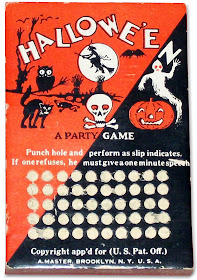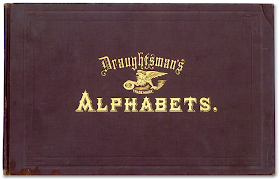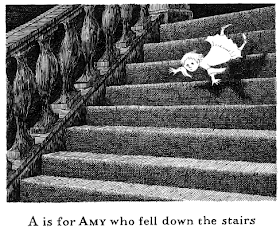Wednesday, October 31, 2012
Devil of a Chance Games
 |
| This 1895 spinner base ball gameboard from Pluto Water features their iconic devil mascot. Pluto Water, was America's natural water laxative. "When Nature Won't, Pluto Will", was their infamous tagline for years. The active ingredient in Pluto Water was sodium and magnesium sulfate, but it also contained lithium salts among other minerals. The sale of Pluto Water was halted in 1971 when lithium became a controlled substance. Hardly a Halloween party game, but the devil is in the details here. From the Library Company of Philadelphia's Flickrstream. |
 |
| A McLoughlin Bros. boardgame from 1901. From the NY Historical Society eMuseum. |
 |
| Betcha can't do these game of Whirl-O skills. Could be yours, on eBay. |
 |
| Jack O' Lantern game of chance from blippee via an Ellen Louwes pin. Looks sort of like pumpkin bingo. |
 |
| Parker Brothers seriously psychic, er psychotic Black Cat Fortune Telling game from 1897 via WorthPoint. |
 |
| Donut toss or cat abuse? From eBay via Vintage Halloween Games Pinterest board. |
 |
| I think I would seriously pass on this party game. Can be yours at eBay. |
Tuesday, October 30, 2012
Stormy Monday
 |
| It Was a Dark and Stormy Night, a game about books and famous first lines from Gone Reading. For all the beleaguered Easterners who weathered the storm last night—may your recovery come quickly in its wake. :: Bottom image from Bas Bleu. |
Monday, October 29, 2012
The Bewitching Hour
 |
| Clever 1930s broom ad. I have no clue why brooms labels were always so colorful in that era, but maybe people did a lot more sweeping back then. From Tortuga's flickrstream. |
 |
| A clipper ship card from Sutton & Co. NY, 1860. Printed by Nesbitt & Co. NY. A crafty name for a ship, but tough to find willing passengers to sail across the ocean I imagine. From Harvard University Library. |
 |
| This thing must run on corn syrup. From riptheskull's flickrstream, but headed the other direction. |
Thursday, October 25, 2012
Fine Lettering Never Goes Out of Date

 |
| Out of print, maybe. Out of date, never! There is no shelf life on fine lettering. These book titles and more are shared by sign painter and pinstriper, Rodney Vicik of Red Rocket Signs on his Flickrstream. As an interesting side note, the book immediately above, titled The Elements of Lettering is co-authored by John Howard Benson (1901-1956), artist, designer, calligrapher and famed stonecarver at The John Stevens Shop in Newport RI. Originally published in 1940, this book is a practical and historical guide for lettering. Benson and his family were the subject of one of my favorite columns which I wrote nearly two years ago in this space (later recast as an article for AIGA). It is the remarkable story of a family of truly noted artists and craftsmen; two of which received MacArthur genius grants for their work. Through John Howard Benson's legacy, his family has gone on to become their own solo art colony. A year or so ago, I had the good fortune to visit JHBs son John and grandson Nick who now runs the shop in Newport, and gained such a respect for the accomplished work they each do. Days later, I was in a used bookstore in Manchester MA, and without thought in mind, I happened to find Benson's lettering book. It was a later 1950 edition printed on poor wood pulp paper, but I treasure it all the same. |
Tuesday, October 23, 2012
Halloween Heresy
 |
| Marginalia of the earliest known illustrated example of a witch on a broomstick in the 1451 manuscript, Hexenflug der Vaudoises (Flight of the Witches), authored by Martin Le France (1410-1461). |

 |
| Though not a witch, this fifteenth century, fractur-licking peasant guy has a frighteningly uncanny resemblance to Moe on The Simpsons. As found on Got Medieval, who cleverly connected the dots/pixels to this mystery of animated ancestry. |
 |
| ::Bewitching images above from Bibliotheque Nationale de France via the Streets of Salem and the Flying Waldensians. Another hat tip goes out to Bollocks and Broomsticks for shedding more light on witches' broomsticks than I care to know. |
Monday, October 22, 2012
Devilish & Freaky Circus Posters
 |
| 1900 chromolith poster for a sterling attraction with Ettgar Sallmito. |
 |
| The Spider Woman with Circus Danielli and his unique collection of Phemomenon. |
 |
| Another live spider woman specimen from the Cirque Ancillotti. |
 |
| The famous Leonaly—Contortionist. 1919 chromolithograph. |
 |
| "A Decapitated Head" every afternoon & evening. All the other entertainments as usual. 1874 handbill. |
 |
| The "54th Year of Pleasure Making" including some sport decapitation and free novelty gifts. Fun for the whole family! :: All of these freaky posters and more can be found at Double-Ms wonderful Flickrstream. |
Thursday, October 18, 2012
Book Surfing
That does it. I have got to learn how to do stop animation. This imaginative work by Salon Alpin, is as much about surfing as it is about books and taking on life's new challenges. It had to be an incredible challenge just to make this story about a bookmark who takes up surfing on the pages of an open book. The team Alpin folks have to be surfers, as every wave, every crest, every splash and nuance of the surfing is spot on. Even the glare of the sun on the curl of the wave brings me back to the beach. After you watch the original, you can learn how it was done here, here and then here. Truly a delight.
Wednesday, October 17, 2012
Tuesday, October 16, 2012
The Alphabeticalamities of The Gashlycrumb Tinies
From Edward Gorey's 1963 macabre children's alphabetical book of calamities, The Gashlycrumb Tinies, performed by Marcus Kihn.
Color Your World

 |
| The inclination to hand-color photos has been around as long as photography has certainly. The New Process Photo-Color book, a pocket-size "palette" from the vast FullTable archives, is a self-contained book of pigment used to paint photos. Simply wet your brush and paint away. No skill involved, but guaranteed to make the most lackluster image shine. As you can see below, there are various styles and methods of coloring photos. I used to use Marshall's brand oil paints which were widely sold at photo supply stores for years, although watercolors, dyes and colored pencils are also useful. When using oils, it was essential to use fiber-base photo papers which allow for the oil to eventually soak in and dry. Before applying any color, I would coat the surface area to be colored with a clear, oil base solution to aid the color application. It would act as a vehicle and thin the color to provide transparency. |
 |
| Le Clowns appear to be colorized with colored pencils, another popular technique. The texture of the photo paper usually is revealed by this method. Image from LovedayLemon's Flickrstream. |
 |
| The Laboratory of Satan. This partially hand-tinted image is one half of "a stereoscopic French devil tissue view (diablerie) from the 1870s", as explained by Wolfgang Wiggers on his Flickrstream. "These tissue views are made of three layers. First is the normal albumen photographic paper. Second is a painted tissue behind the photograph. Third is a white protection tissue. If you hold the picture against a light, the colors come through. The glowing eyes of the skulls are pinpricked and labeled with a red translucent material." Is that green absinthe Satan is drinking? Below is the same image converted to anaglyph using the freeware stereo image editor, StereoPhoto Maker. If you have any 3D glasses on hand, you can actually view Satan's workshop in 3D.  |































